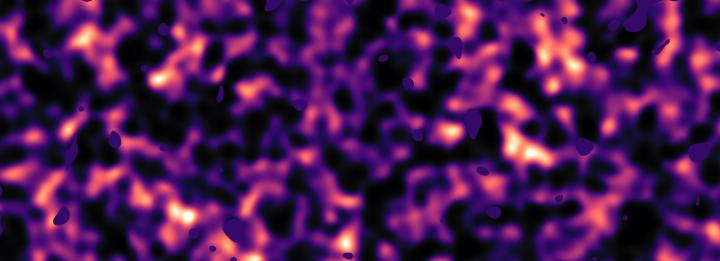Scientists have gained fresh insight into the nature of dark matter, the elusive material that accounts for much of the mass of the Universe.
Calculations based on a study of distant galaxies, using a powerful telescope, suggest that dark matter is less dense and more smoothly distributed throughout space than previously thought.
The results, from an international team of scientists, will inform efforts to understand how the Universe has evolved in the 14 billion years since the Big Bang, by helping to refine theoretical models of how it developed.
Scientists studied wide-area images of the distant universe, taken from the European Southern Observatory in Chile.
They applied a technique based on the bending of light by gravity – known as weak gravitational lensing – to map out the distribution of dark matter in the Universe today. Their study represents the largest area of the sky to be mapped using this technique to date.
To eliminate bias in their results, scientists carried out three sets of calculations, including two false sets, only revealing to themselves at the outcome which of the sets was real.
The new results contradict previous predictions from a survey of the far-off universe, representing a point in time soon after the Big Bang, imaged by the European Space Agency’s Planck satellite. This previous study used a theoretical model to project how the Universe should appear today.
The disagreement between this prediction and the latest direct measurements suggests that scientists’ understanding of the evolving modern day Universe is incomplete and needs more research.
The latest study, published in Monthly Notices of the Royal Astronomical Society, was carried out by a team jointly led by the University of Edinburgh, the Argelander Institute for Astronomy in Germany, Leiden University in the Netherlands and Swinburne University of Technology, Australia in an ongoing project called the Kilo Degree Survey, or KiDS. It was supported by the European Research Council.
Dr Hendrik Hildebrandt of the Argelander Institute for Astronomy in Germany, who co-led the study, said: “Our findings will help to refine our theoretical model for how the Universe has grown since its inception, improving our understanding of the modern day Universe.”
Dr Massimo Viola of Leiden University in the Netherlands, who co-led the study, said: “This latest result indicates that the cosmic web dark matter, which accounts for about one-quarter of the Universe, is less clumpy than we previously believed.”
Professor Catherine Heymans of the University of Edinburgh’s School of Physics and Astronomy, who co-led the study, said: “Unravelling what has happened since the Big Bang is a complex challenge, but by continuing to study the distant skies, we can build a picture of how our modern Universe has evolved.”


